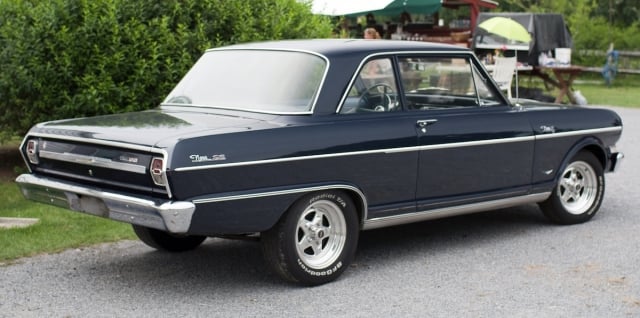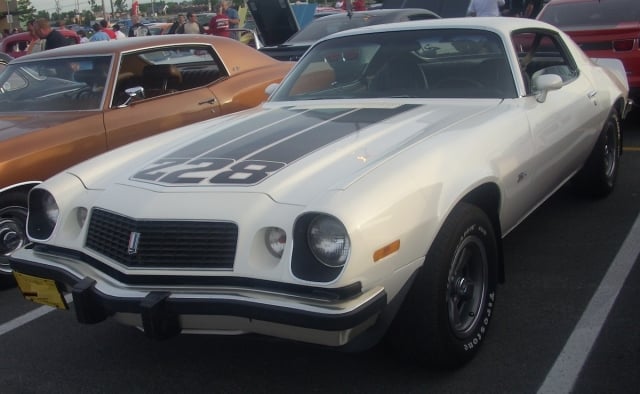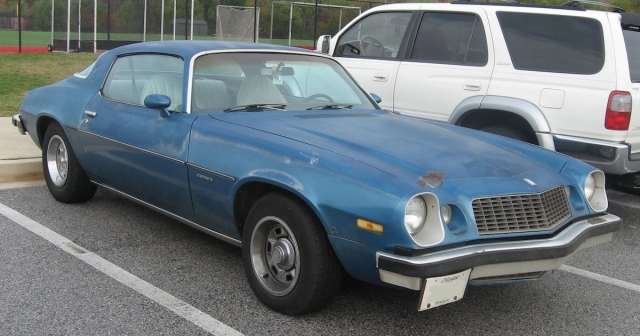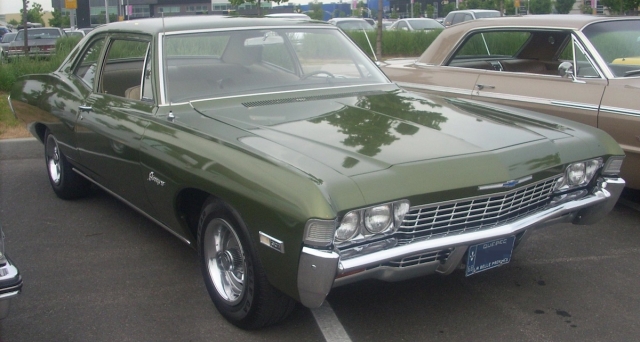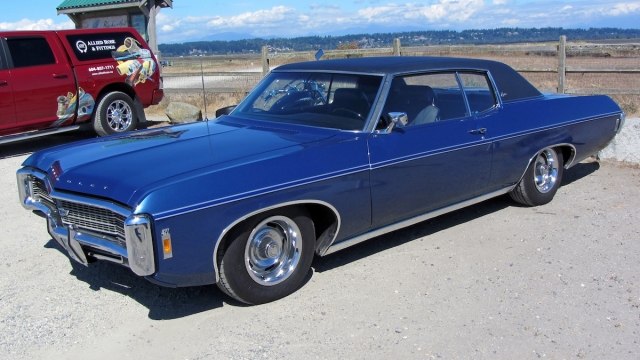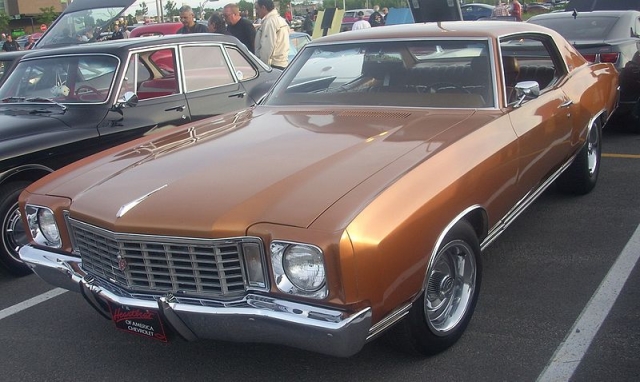Finding an affordable musclecar that has a reasonable price tag and one that will gain value at a steady rate like the most desirable collector cars can be a tough task. We’ve taken a shot at presenting the top five cars that fit into this category.
Before we get started, there are some terms that must be defined so that everyone understands the ground rules. Webster’s dictionary defines musclecars as “any of a group of American-made 2-door sports coupes with powerful engines designed for high-performance driving.” It goes on to state that musclecars, “have a V8 engine fitted into a two-door, rear wheel drive, family-style mid-size or full-size car designed for four or more passengers. Muscle cars are intended mainly for street use and occasional drag racing.”
Parameters
Not all car enthusiasts agree with the definition of muscle car listed above, but we can draw some parameters out to use in order to give us a decent comparison and narrow down the field to select from. We consider a musclecar to be a rear wheel drive, American made coupe with an occupancy greater than 2 people. To be a true musclecar, the vehicle should have originated from the 1950s to the early 1970s. To meet the affordability requirement, we put a cap of $8,000 on the purchase price for a vehicle in the class three condition. In this price range you’re not buying a rapid value gainer investment grade collector car but these cars shouldn’t lose value, if you follow our advice.
According to Hagerty Insurance, Class three cars have a decent exterior and may possess a fresh or new paint job (does not have to be original), correct interior, drive and run well but might have some incorrect parts. These cars are not used for daily transportation but are ready for a long tour without excuses, and a casual passerby will not find any visual flaws. “Good” is the one word description of a class three car.
For our needs, a class three car will be in presentable condition but showing signs of wear and use. The paint may be failing but no rusted through panels are present. The car is in safe operating condition but may need minor mechanical repairs.
The late ‘60s to the early ‘70s are generally considered the golden age of classic musclecars. This is the height of musclecar manufacturers one-upsmanship. The period just before environmental regulations and the oil crisis forced horsepower restrictions. Here’s our top five affordable collector musclecars that you can still find from the golden era:
# 1: Chevy Nova (Gen 1, 2 & 3)
It’s no mystery that the Chevy Nova is an affordable musclecar. The worth of these Mid-Century “economy” cars stays at a constant level without many dips or rises in the value. You won’t see a lot of growth in the cost potential of these cars except the specialty versions like the Yenko Novas. For our purposes, we kept with the very basic two-door hardtop coupe with a V8 engine.
Nova’s were manufactured from 1962 through 1979 and returned from 1985 through 1988 for five generations of the nameplate. Starting as the top model in the Chevy II line-up, Nova became it’s own nameplate in 1969. The Nova’s reign as a musclecar ended in 1979 when it was replaced by the front wheel drive Citation. An attempted comeback in 1985 as a subcompact with front wheel drive doomed the once proud musclecar.
Our favorite years for the Nova range through the first 3-generations of the nameplate from 1963 through 1974.
If you are looking for a first-generation Nova, the 1964, 2-door hardtop coupe is a great choice. The 1964 model year was the first year with a V8 option with the 283cid/195hp that lists around $6,725.00. This car has remained steady over the long trend so you probably won’t see any major price changes for this year and model.
Our pick for a second-generation Nova would be the 1967 Nova, 2-door hardtop coupe with 307cid/200hp V8 that averages $5,725.00 for a class three car. The Chevy Camaro was released in 1967 which robbed some sales of the Nova. Because of this, there are fewer of the 1967 models than there were of the 1966 model year Novas. Scarcity may help this classic with value over the long haul.
The 1972, 2-door hardtop coupe, valued at $5725.00 would be our choice for a third-generation Nova. The Nova production was moved to the Norwood, Ohio plant in 1972 where it could be assembled alongside the Camaro. The mid-year Novas offered a sunroof option and the optional Strato bucket seats, which were introduced to the Camaros and Vegas the previous year, are items to look for. This would be the most popular year in Nova sales to this point. Because of the popularity, the value of these cars could see an increase just due to volume. In 1973 and 1974 the Novas had larger bumpers both fore and aft for a major appearance change along with more stringent emissions controls that make those model years less desirable.
What To Look For
When you have a lead on a potential project car, you have to be aware of the inherent flaws or areas that show a high rate of rust. Chevrolet suspensions from this period can wear out quickly. Lower ball joints did not last long, especially if they were not lubricated regularly. Novas used GM’s independent system in the front which featured unequal-length A-arms, coil springs, tube shocks and anti-roll bar. Steering was recirculating-ball with optional power assist. Once any of these components is worn, the others are subjected to more stress and quicker wear. Front end replacement parts and kits are readily available and very affordable.
The rear suspension consisted of a solid axle, coil springs, tube shocks and a four-link Panhard bar. The rear suspension should be checked carefully because the rear framerails can rust and have to be cut off and replaced if they are weak. Rusted frame rails can spread like cancer and may lead to structural problems with the spring perches and axle housing.
The Nova featured an all-steel body mounted on front and rear sub-frames. These bodies are notorious for rust, particularly the lower sections of the fenders, quarter panels and doors, as well as the rear inner quarters, taillamp panel (caused by leaking taillamp gaskets), rear window, battery tray, radiator support, trunk pan and rear framerails, which were welded to the body. Most of the water seeps in due to dried windshield and rear-window gaskets. Leaf springs are rust-prone. Other areas to look at are sagging doors, caused by worn hinge bushings and/or pins, and sagging front and rear springs. The front sub-frames are sturdy and easily removed for restoration.
The interior featured cloth seat covers that wore quickly. The basic door panels were thin, with very few parts to break, but often did. Rear package shelves can get wet due to leaky rear-window gaskets and warp.
#2: 1974 Chevy Camaro, Two-Door Coupe
Chevy Camaros are always near and dear to hardcore Chevy fans, especially the first-generation Camaros. An average Camaro in average condition for the first generation will run over $20 thousand. Way out of the affordable limits that we have outlined. To be a true affordable and collector Camaro, we had to go to 1974 to find a second-generation Camaro that is under ten-thousand dollars.
Federal regulations on bumper impact standards forced a facelift for all cars in 1974 model year and the Camaro got a major appearance change. New extruded aluminum bumpers were featured both front and rear which added nearly seven inches to overall length. Production of the Camaro was up, despite gasoline shortages and substantial price increases, 151,008 were built for the ‘74 model year.
Remember that we wanted to stay away from the environmental regulation changes in the 1975 and later vehicles so the only choice is the ’74 2-door hardtop coupe.The current market value for a class three ’74 Camaro in base model form is $7,775.00. It wasn’t the biggest, fastest monster on the street, but it was a great package that left little to be desired.
What To Look For
Like the Nova listed above, the Camaro is a uni-body design, which means the rear quarter panels are part of the rigid frame/structure. You will want to make sure the quarter panels have not been replaced. If they have been replaced, you need to have the car checked for a bent or twisted uni-body. A wrecked and rebuilt car on a damaged frame will never drive right.
Besides the obvious potential for damaged frames and suspensions from past abuse, rust around the windshield and rear window is common, as is miscellaneous body rust. It’s best to find a car with it’s original sheet metal. Even if there’s some rust it’s better than a car filled with patches.
The plastic content increased on cars in order to create a lighter car and lower production costs of the vehicle. However, after 25 to 30 years they almost always have deteriorated to a point where they need attention. Color fading and disintegration is common in these plastic interior parts.
#3: 1968 Chevy Biscayne, Two-Door Hardtop
The Biscaynes tended to be a real “no-frills” type car, often used as fleet vehicles, that didn’t have the luxury convenience options available on the more expensive full-sized Chevrolet models. No power windows, rear armrests and the interior trim was spartan, with lower-grade cloth and vinyl or all-vinyl upholstery trim, a standard steering wheel with center horn button, and rubber floor mats. This minimalist approach to car building led to a lighter car, often referred to as “stripped down” models or “strippers.”
These are more common than the high performance models that are sought out by collectors today. One of the more prized Biscaynes of the period is the Baldwin Motion “Street Racer Special,” which was a ’68 Biscayne with a dealer fitted 427cid V8 and upgraded suspension which turned the plain Jane into a serious drag car.
Saavy car enthusiasts can snap up these inexpensive sleepers and turn them into a street racing “Bisquick” with an engine swap and some suspension work. This is the epitome of a “sleeper” car.
What To Look For
The biggest thing on cars from this period, no matter what the body style, is rust. Rust is the thing you try to stay away from when making a purchase. There’s really no such thing as “a little” rust repair. The full-size Chevys have certain areas that are prone to rust. Areas to check include the lower front fenders, bottoms of the quarter panels, trunk pans, floor pans and front windshield track. The windshield track is difficult to see if it is rusted but the others are fairly easy to spot. If you see a car that has had some work done in these areas, take a magnet and place it over a sheet of paper at these spots. The paper will prevent scaring the paint job. If the magnet doesn’t stick, then that area has been patched with body filler.
#4: 1969 Chevy Caprice, Two-Door Hardtop
The full-sized Chevy Caprice was a staple in the GM line from 1965 through the 1996 model years. One of the most popular body styles ever, the full-sized Chevrolet models sold over a million cars in 1965, but by 1969 the total production for the Caprice models dropped to 166,900, losing favor to the more popular Bel Air, Biscayne and Impala models.
For 1969 the Caprice was entering the last years of the first generation design. To freshen the body up a bit GM reshaped the fender bulge around each wheel well and added rectangular tail lamps in a thinner bumper. Overall, the car had crisper body lines and front bumpers that wrapped around the grille.
Inside, the front seat headrests were now standard equipment due to a federal safety mandate and the ignition switch moved from the dashboard to the steering column and doubled as a lock for the steering wheel when the key was removed.
The 1969 Caprice also offered a new GM-designed variable-ratio power steering unit as optional equipment. A new 350cid Turbo Fire V8 engine, rated at 255 and 300 HP was available and like all the other V8 engine models, they were available with the three-speed Turbo Hydramatic transmission for the first time although the two-speed Powerglide was still offered with the 350 V8s.
If you are looking at getting into the collector car hobby but don’t want to buy a pony car, there are few better places to invest your money than a Caprice. They represent a part of American iron that is still respected and affordable today. Valued at $7,043.00 for the two-door hardtop with 350cid engine.
What To Look For
Inspect the car for rust and rot. Even if the top side is shiny doesn’t mean everything’s ok underneath. The moldings down the sides of the car are likely to show signs of parking lot dings, if the molding is still there. A routine problem area for these model year caprices are rust on the edges of the truck lids. Check the wheel wells and panels under the front windshield and back window.
#5: 1973 Chevy Monte Carlo, Two-Door Coupe
The intermediate-sized Monte Carlo was redesigned in its third year and wound up as Motor Trend’s Car of the Year for 1973. The car buying public agreed and Chevrolet’s Monte Carlo set a new sales record for the brand with nearly 250,000 sold for the model year.
By 1973 the nameplate dropped the two-door hardtop and became a pillared coupe with side opera windows and frameless door glass. The front bumper was changed in large part because of the federally mandated 5-MPH bumpers. Also new was a double-shell roof for improved noise reduction and rollover protection along with the flush-mounted pull-up exterior door handles.
Before departing to form his own company in 1972, general manager John Z. DeLorean had ordered that Monte Carlo suspensions be sport-tuned which continued into the 1973 model year. Sporting deeply sculpted bodysides, these Monte Carlos adopted the basic long-hood/short-deck theme of previous models. Overall length grew by four inches, width by two. We highlighted the optional 350cid V8 engine with a four-barrel carburetor as our choice for best potential for growth in this price range.
What To Look For
Several areas of concern have become common on the second generation Monte Carlos. Rust areas in panels near windows, especially near the rear window in vehicles with a vinyl top. The vinyl tops are susceptible to cracking and allowing rain to get in through the vinyl and collect in puddles on the metal. Rust in the bottom of the rear quarterpanels where moisture on bare parts is common along with gas tank rust, inside and out. The gas tank rust is an easy fix by simply changing the component out for a replacement. Body cancer is a different story however.
Where To Look For Your Potential Investment Car
The internet has become a great source of all things automotive and internet savvy shoppers know how to use eBay’s filter to search for cars by state. Internet auction advertisements have helped the marketplace by giving shoppers a means of searching for online car auctions for classic musclecars or street cars. Keep in mind that distance could be an issue if you have to travel too far to get the car of your dreams. In addition to eBay Motors, craigslist has become a valuable source for local car listings.
Even with the internet, local listings in newspapers and penny-saver types of ad magazines for the local area can also be a treasure map for inexpensive musclecars.
How To Negotiate
It’s a fact that your budget priced musclecar is going to need a few upgrades along the way so you are going to want to save as much as possible on the old Nova, Caprice, Camaro or other musclecar. Here is a quick guide on how to save a few bucks when buying that new investment.
Go to your bank or credit union and get pre-approved. Having cash or a check in hand will put the negotiation power back in your court. Comparison Shop. Find more than one car that you are interested in, hopefully the same type, model and year, so you can compare and choose the best deal.
Negotiate. Actually sit down with the seller and ask what his bottom dollar is. He may or may not give you a break on the price of the car. However, if you never ask, you certainly won’t receive a discount.
Seal The Deal
Do a Gut Check, can you be happy with the car you’ve chosen for sometime? If not you may have buyer’s remorse and end up selling the car for less than you paid just to get it out of your garage. Buy a car you’ll love having for a long time. If you love the car, it will be a labor of love to restore it back to greatness.







